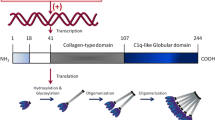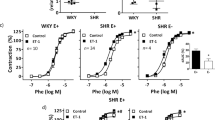Abstract
Adiponectin exerts vasodilatory effects. Irbesartan, an angiotensin receptor blocker, possesses partial peroxisome proliferator-activated receptor gamma (PPAR-γ) agonist activity and increases circulating adiponectin. This study explored the effect of irbesartan alone and in combination with adiponectin on blood pressure, renal hemodynamic excretory function, and vasoactive responses to angiotensin II and adrenergic agonists in spontaneously hypertensive rat (SHR). Irbesartan was given orally (30 mg/kg/day) for 28 days and adiponectin intraperitoneally (2.5 μg/kg/day) for last 7 days. Groups of SHR received either irbesartan or adiponectin or in combination. A group of Wistar Kyoto rats (WKY) served as controls. Metabolic data and plasma samples were taken on days 0, 21, and 28. In acute studies, the renal vasoconstrictor actions of angiotensin II (ANGII), noradrenaline (NA), phenylephrine (PE), and methoxamine (ME) were determined. SHR control rats had a higher mean blood pressure than the WKY (132 ± 7 vs. 98 ± 2 mmHg), lower plasma and urinary adiponectin, creatinine clearance, urine flow rate and sodium excretion, and oxidative stress markers compared to WKY (all P < 0.05) which were progressively normalized by the individual drug treatments and to a greater extent by combined treatment. Responses to intrarenal administration of NA, PE, ME, and ANGII were larger in SHR (P < 0.05) than WKY by 20–25 %. Irbesartan enhanced (P < 0.05) responses to NA and PE, while adiponectin blunted responses to all vasoconstrictors (all P < 0.05). Combined treatment in SHR further decreased the renal vascular responses to ANGII. These findings suggest that an interactive relationship may exist between PPAR-γ, alpha adrenoceptors, and ANGII in the renal vasculature of the SHR.



Similar content being viewed by others
References
Abdulla MH, Sattar MA, Abdullah NA, Khan MA, Abdallah HH, Johns EJ (2009) Chronic treatment with losartan and carvedilol differentially modulates renal vascular responses to sympathomimetics compared to treatment with individual agents in normal Wistar Kyoto and spontaneously hypertensive rats. Eur J Pharmacol 612:69–74
Abdulla MH, Sattar MA, Khan MA, Abdullah NA, Johns EJ (2009) Influence of sympathetic and AT-receptor blockade on angiotensin II and adrenergic agonist-induced renal vasoconstrictions in spontaneously hypertensive rats. Acta Physiol 195:397–404
Alexander WD, Branch RA, Levine DF, Hartog M (1977) The urinary sodium: potassium ratio and response to diuretics in resistant oedema. Postgrad Med J 53:117–121
Armando I, Carranza A, Nishimura Y, Hoe KL, Barontini M, Terron JA et al (2001) Peripheral administration of an angiotensin II AT[1] receptor antagonist decreases the hypothalamic-pituitary-adrenal response to isolation stress. J Endocrinol 142:3880–3889
Beierwaltes WH, Arendshorst WJ, Klemmer PJ (1982) Electrolyte and water balance in young spontaneously hypertensive rats. Hypertension 4:908–915
Bolterman RJ, Manriquez MC, Ortiz Ruiz MC, Juncos LA, Romero JC (2005) Effects of captopril on the renin angiotensin system, oxidative stress, and endothelin in normal and hypertensive rats. Hypertension 46:943–947
Chabrashvili T, Kitiyakara C, Blau J, Karber A, Aslam S, Welch WJ et al (2003) Effects of ANG II type 1 and 2 receptors on oxidative stress, renal NADPH oxidase, and SOD expression. Am J Physiol Regul Integr Comp Physiol 285:117–124
Chen H, Montagnani M, Funahashi T, Shimomura I, Quon MJ (2003) Adiponectin stimulates production of nitric oxide in vascular endothelial cells. J Biol Chem 278:45021–45026
Christou GA, Kiortsis DN (2014) The role of adiponectin in renal physiology and development of albuminuria. J Endocrinol 221:13–0578
Clasen R, Schupp M, Foryst-Ludwig A, Sprang C, Clemenz M, Krikov M et al (2005) PPARgamma-activating angiotensin type-1 receptor blockers induce adiponectin. Hypertension 46:137–143
Cowley AW Jr, Roman RJ (1996) The role of the kidney in hypertension. JAMA 275:1581–1589
de Gasparo M, Catt KJ, Inagami T, Wright JW, Unger T (2000) International union of pharmacology. XXIII. The angiotensin II receptors. Pharmacol Rev 52:415–472
Fruebis J, Tsao T-S, Javorschi S, Ebbets-Reed D, Erickson MRS, Yen FT et al (2001) Proteolytic cleavage product of 30-kDa adipocyte complement-related protein increases fatty acid oxidation in muscle and causes weight loss in mice. Proc Natl Acad Sci U S A 98:2005–2010
Fu M, Zhou J, Qian J, Jin X, Zhu H, Zhong C et al (2012) Adiponectin through its biphasic serum level is a useful biomarker during transition from diastolic dysfunction to systolic dysfunction—an experimental study. Lipids Health Dis 11:106
Gardiner SM, Kemp PA, March JE, Bennett T (1993) Regional haemodynamic effects of angiotensin II [3–8] in conscious rats. Br J Pharmacol 110:159–162
Iwai M, Kanno H, Senba I, Nakaoka H, Moritani T, Horiuchi M (2011) Irbesartan increased PPARgamma activity in vivo in white adipose tissue of atherosclerotic mice and improved adipose tissue dysfunction. Biochem Biophys Res Commun 406:123–126
Iwaki M, Matsuda M, Maeda N, Funahashi T, Matsuzawa Y, Makishima M et al (2003) Induction of adiponectin, a fat-derived antidiabetic and antiatherogenic factor, by nuclear receptors. Diabetes 52:1655–1663
Iwashima Y, Katsuya T, Ishikawa K, Ouchi N, Ohishi M, Sugimoto K et al (2004) Hypoadiponectinemia is an independent risk factor for hypertension. Hypertension 43:1318–1323
Jiang X, Song D, Ye B, Wang X, Song G, Yang S et al (2011) Effect of intermittent administration of adiponectin on bone regeneration following mandibular osteodistraction in rabbits. J Orthop Res 29:1081–1085
Kusminski C, McTernan PG, Schraw T, Kos K, O’Hare JP, Ahima R et al (2007) Adiponectin complexes in human cerebrospinal fluid: distinct complex distribution from serum. Diabetologia 50:634–642
Liu M, Zhou L, Xu A, Lam KS, Wetzel MD, Xiang R et al (2008) A disulfide-bond A oxidoreductase-like protein [DsbA-L] regulates adiponectin multimerization. Proc Natl Acad Sci U S A. doi:10.1073/0806341105
Pinho MJ, Serrao MP, Soares-da-Silva P (2007) High-salt intake and the renal expression of amino acid transporters in spontaneously hypertensive rats. Am J Physiol Renal Physiol 292:1452–1463
Ran J, Hirano T, Fukui T, Saito K, Kageyama H, Okada K et al (2006) Angiotensin II infusion decreases plasma adiponectin level via its type 1 receptor in rats: an implication for hypertension-related insulin resistance. Metabolism 55:478–488
Ravera M, Ratto E, Vettoretti S, Parodi D, Deferrari G (2005) Prevention and treatment of diabetic nephropathy: the program for irbesartan mortality and morbidity evaluation. J Am Soc Nephrol 16:48–52
Sarafidis PA, Lasaridis AN (2006) Actions of peroxisome proliferator-activated receptors-γ agonists explaining blood pressure lowering effect. Am J Hypertens 19:646–653
Schupp M, Janke J, Clasen R, Unger T, Kintscher U (2004) Angiotensin type 1 receptor blockers induce peroxisome proliferator-activated receptor-γ activity. Circulation 109:2054–2057
Sica DA, Bakris GL (2002) Type 2 diabetes: RENAAL and IDNT—the emergence of new treatment options. J Clin Hypertens 4:52–57
Sugawara A, Uruno A, Kudo M, Matsuda K, Yang CW, Ito S (2011) PPARγ agonist beyond glucose lowering effect. Korean J Intern Med 26:19–24
Tanida M, Shen J, Horii Y, Matsuda M, Kihara S, Funahashi T et al (2007) Effects of adiponectin on the renal sympathetic nerve activity and blood pressure in rats. Exp Biol Med [Maywood] 232:390–397
Vaishya R, Singh J, Lal H (2008) Effect of irbesartan on streptozotocin induced diabetic nephropathy: an interventionary study. Indian J Clin Biochem 23:195–197
Vittorio TJ, Lang CC, Katz SD, Packer M, Mancini DM, Jorde UP (2003) Vasopressor response to angiotensin II infusion in patients with chronic heart failure receiving β-blockers. Circulation 107:290–293
Wu L, Wang R, De Champlain J, Wilson TW (2004) Beneficial and deleterious effects of rosiglitazone on hypertension development in spontaneously hypertensive rats. Am J Hypertens 17:749–756
Yamauchi T, Kamon J, Minokoshi Y, Ito Y, Waki H, Uchida S et al (2002) Adiponectin stimulates glucose utilization and fatty-acid oxidation by activating AMP-activated protein kinase. Nat Med 8:1288–1295
Yilmaz MI, Sonmez A, Caglar K, Celik T, Yenicesu M, Eyileten T et al (2007) Effect of antihypertensive agents on plasma adiponectin levels in hypertensive patients with metabolic syndrome. Nephrology 12:147–153
Zorad S, J-t D, Benicky J, Hutanu D, Tybitanclova K, Zhou J et al (2006) Long-term angiotensin II AT1 receptor inhibition produces adipose tissue hypotrophy accompanied by increased expression of adiponectin and PPARγ. Eur J Pharmacol 552:112–122
Acknowledgments
The authors fully acknowledge the Universiti Sains Malaysia, Research grant no. 1001/PFARMASI/815078, provided by Universiti Sains Malaysia for this work.
Sheryar Afzal is a recipient of USM Fellowship from the Institute of Post-Graduate Studies (IPS), Universiti Sains Malaysia (USM), Penang, Malaysia, and this support is gratefully acknowledged.
Author information
Authors and Affiliations
Corresponding author
Additional information
Institute
The present experiment was conducted in Cardiovascular and Renal Physiology Lab, School of Pharmaceutical Sciences, Universiti Sains Malaysia, Penang, 11800, Malaysia
Rights and permissions
About this article
Cite this article
Afzal, S., Sattar, M.A., Johns, E.J. et al. Interaction between irbesartan, peroxisome proliferator-activated receptor (PPAR-γ), and adiponectin in the regulation of blood pressure and renal function in spontaneously hypertensive rats. J Physiol Biochem 72, 593–604 (2016). https://doi.org/10.1007/s13105-016-0497-1
Received:
Accepted:
Published:
Issue Date:
DOI: https://doi.org/10.1007/s13105-016-0497-1




